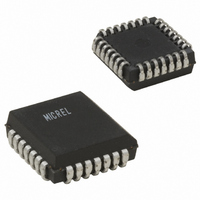SY89430VJZ Micrel Inc, SY89430VJZ Datasheet - Page 6

SY89430VJZ
Manufacturer Part Number
SY89430VJZ
Description
5V/3.3V Programmable Frequency Synthesizer (50-950MHz) ( )
Manufacturer
Micrel Inc
Series
Precision Edge®r
Type
Frequency Synthesizerr
Datasheet
1.SY89430VZH.pdf
(11 pages)
Specifications of SY89430VJZ
Pll
Yes
Input
Crystal
Output
PECL
Number Of Circuits
1
Ratio - Input:output
1:1
Differential - Input:output
No/Yes
Frequency - Max
950MHz
Divider/multiplier
Yes/No
Voltage - Supply
3.135 V ~ 5.25 V
Operating Temperature
0°C ~ 75°C
Mounting Type
Surface Mount
Package / Case
28-LCC (J-Lead)
Frequency-max
950MHz
Number Of Elements
1
Supply Current
220mA
Pll Input Freq (min)
10MHz
Pll Input Freq (max)
25MHz
Operating Supply Voltage (typ)
3.3/5V
Operating Temp Range
0C to 75C
Package Type
PLCC
Output Frequency Range
50 to 950MHz
Operating Supply Voltage (min)
3.135V
Operating Supply Voltage (max)
5.25V
Operating Temperature Classification
Commercial
Pin Count
28
Lead Free Status / RoHS Status
Lead free / RoHS Compliant
Other names
576-2560
SY89430VJZ
SY89430VJZ
Available stocks
Company
Part Number
Manufacturer
Quantity
Price
Company:
Part Number:
SY89430VJZ
Manufacturer:
Microchip
Quantity:
1 905
Micrel, Inc.
configuring the internal dividers to produce the desired
frequency at the outputs. The output frequency can be
represented by this formula:
modulus, and N is the output divider modulus. Note that it is
possible to select values of M such that the PLL is unable to
achieve loop lock. To avoid this, always make sure that M is
selected to be 200 ≤ M ≤ 510 for a 16MHz input reference.
through the parallel interface, and then possibly again through
the serial interface. This approach allows the designer to bring
up the application at one frequency and then change or fine-
tune the clock, as the ability to control the serial interface
becomes available. To minimize transients in the frequency
domain, the output should be varied in the smallest step size
possible.
M9999-011106
hbwhelp@micrel.com or (408) 955-1690
T2
PROGRAMMING INTERFACE
0
0
0
0
1
1
1
1
Programming the device is accomplished by properly
Where F
M[8:0] and N[1:0] are normally specified once at power-on,
S
_CLOCK
S
S
P
M[8:0]
N[1:0]
T1
_DATA
_LOAD
_LOAD
0
0
1
1
0
0
1
1
XTAL
T0
0
1
0
1
0
1
0
1
is the crystal frequency, M is the loop divider
FOUT = (
Data Out – Last Bit SR
HIGH
FREF
M Counter Output
FOUT
LOW
S_
FOUT ÷ 4
CLOCK
M,N
÷ M
TEST
FXTAL
T2
8
First
Bit
) x
T1
M
N
T0
FVCO ÷ N
FVCO ÷ N
FVCO ÷ N
FVCO ÷ N
FVCO ÷ N
FVCO ÷ N
S_
FVCO ÷ N
FOUT / FOUT
CLOCK
N1
÷ N
N0
M8
6
internal nodes (as determined by the T[1:0] bits in the serial
configuration stream). It is not configurable through the parallel
interface. Although it is possible to select the node that
represents FOUT, the TTL output may not be able to toggle
fast enough for some of the higher output frequencies. The T2,
T1, T0 configuration latches are preset to 000 when P_LOAD
is low, so that the FOUT outputs are as jitter-free as possible.
The serial configuration port can be used to select one of the
alternate functions for this pin.
register with the next two and the M register with the final eight
bits of the data stream on the S_
the most significant bit is loaded first (T2, N1 and M8).
bypass mode. In this mode the S_
into the M and N dividers. The N divider drives the FOUT
differential pair and the M counter drives the TEST output pin.
In this mode the S_
board level functional test or debug. Bypassing the PLL and
driving FOUT directly gives the user more control on the test
clocks sent through the clock tree (See detailed Block Diagram).
Because the S_
limited to 250MHz or less. This means the fastest the FOUT
pin can be toggled via the S_
minimum divide ratio of the N counter is 2. Note that the M
counter output on the TEST output will not be a 50% duty cycle
due to the way the divider is implemented.
M7
The TEST output provides visibility for one of several
The Test register is loaded with the first three bits, the N
When T[2:0] is set to 100 the SY89430V is placed in PLL
M6
M5
CLOCK
M4
CLOCK
is a TTL level the input frequency is
input could be used for low speed
DATA
CLOCK
CLOCK
input. For each register
Last
Bit
is 125MHz as the
input is fed directly
Precision Edge
SY89430V
®















